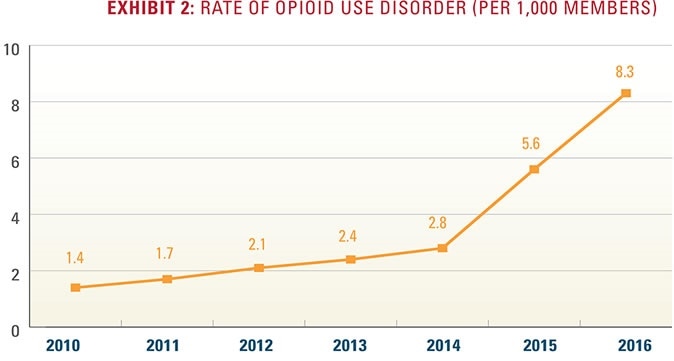A new study has found that more and more Americans are being diagnosed with opioid addiction and the numbers that receive treatment are still very few. This finding is consistent with earlier findings from Blue Cross Blue Shield when analyzing member data.
It has been seen that 20 million Americans have substance abuse problems and of these 10% are opioid addicts. The U.S. Centers for Disease Control and Prevention says that 91 people die each day from opioid overdose and in 2015 over 33,000 persons lost their lives to opioid usage. Drug overdosage including opioid overdose kills more persons than guns or car accidents says the CDC. Synthetic opioids such as Fentanyl kills more persons than before with a jump of 72% from 2014 to 2015. The reports from the National Institutes of Health suggest that prescription drugs are the initiators in persons with illicit drug abuse such as heroin wherein nearly 75% of the persons began with prescription opioids.
Blue Cross Blue Shield analyzed member data between 2010 and 2016 and found the number of persons who were diagnosed with addiction to opioids – including legal prescription drugs and illegal street drugs, had risen by 493%. In 2010 there were only 1.4 cases of opioid use disorder in every 1,000 strong population. By 2016 the number had risen to 8.3 in every 1,000. Only a 65% rise in effective management / treatment was obeserved over the study period period.

Further Blue Cross Blue Shield members noted that persons who were prescribed opioids for longer were more likely to develop opioid addictions. Prescriptions of opioids for medical reasons over 8 or more days raise the risk of later addiction by 13.5% and prescriptions of 31 days or more raises the risk by 29.9%. This was found in a recent CDC study. To curb this, Connecticut, Massachusetts, Rhode Island, New York, and Maine and now New Jersey, after this study reports have limited the opioid prescriptions to less than 7 days. The report from Blue Cross Blue Sheild also finds that 21% of the insured members under it have filled at least one opioid prescription in 2015. This was after they excluded cancer and palliative care patients. Of these 6% were prescribed a high dosage for longer than 90 days.
Abuse liability in the Blue Cross Blue Shield study was found to be higher among women over 45 years compared to men. CDC reports are similar and they note that the rise among women who overdose and die as a result have increased by 400% compared to 265% in men.
Effective treatment for opioid addition is termed as MAT or Medication-assisted treatment. It is the “gold standard” for treatment of this condition. It includes use of medications such as buprenorphine or methadone for effective withdrawal from opioids as well as behavioral therapy. There have been several studies that have supported the effective use of MAT. For example a combination of Buprenorphine and Naloxone is termed as Suboxone and its use could double the chances that a person would remain free of the drug for 18 months after initiation of treatment. Use of buprenorphine also correlates directly with reduction of deaths due to opioid overdose. Along with MAT detoxification programs such as Narcotics Anonymous could help reduce the risks of relapses.
MAT is provided by few centers and the private sector treatments tend not to offer medications that have been approved by the Food and Drug Administration for substance use disorders. Same is true for the publicly funded treatment centers wherein only 23% offered these medications.
According to Dr. Trent Haywood, senior vice president and chief medical officer for Blue Cross Blue Shield, opioid addition is a complex condition and single pronged approach is liable to failure. Collaboration among the healthcare professions, families, friends, insurance providers, employers and the community is an important factor to meet the goals of reduction in the numbers of opioid addicts.
Kim Holland, vice president of state affairs for Blue Cross Blue Shield has said that the companies under it are taking steps to help reduce the numbers of opioid addicts by collaborating with the families and communities.
Source: “America’s Opioid Epidemic and Its Effect on the Nation’s Commercially Insured Population